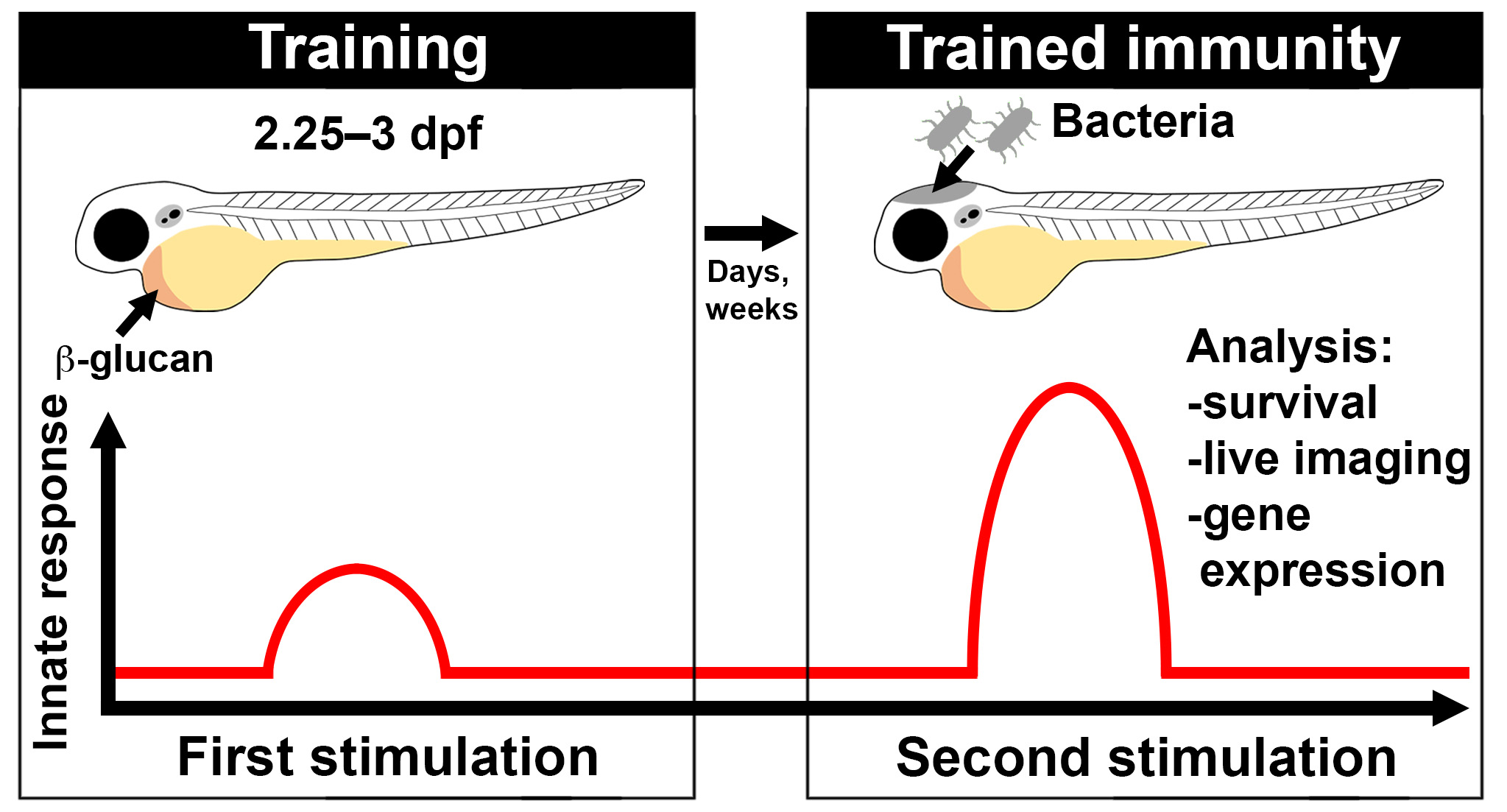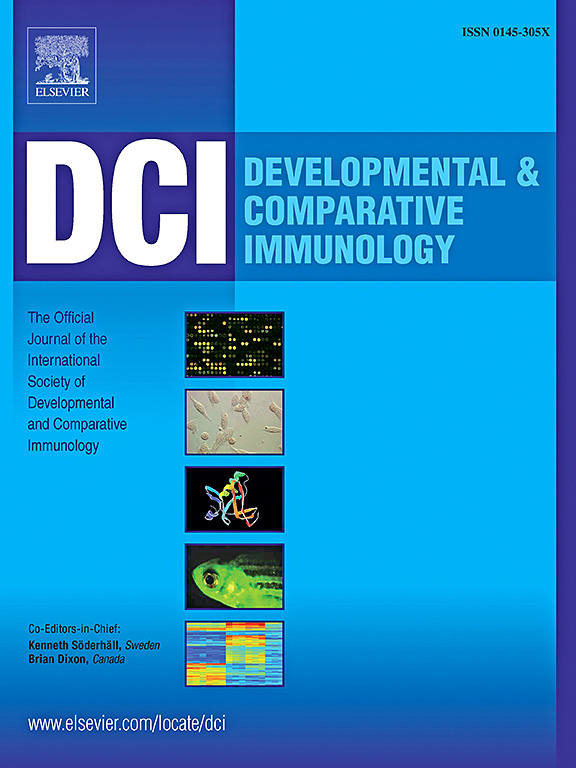- EN - English
- CN - 中文
Microinjection of β-glucan Into Larval Zebrafish (Danio rerio) for the Assessment of a Trained-Like Immunity Phenotype
向幼年斑马鱼(Danio rerio)体内显微注射β-葡聚糖以评估训练样的免疫表型
发布: 2023年12月05日第13卷第23期 DOI: 10.21769/BioProtoc.4888 浏览次数: 2044
评审: Alba BlesaWei FanAlberto Rissone
Abstract
The innate immune system can remember previous inflammatory insults, enabling long-term heightened responsiveness to secondary immune challenges in a process termed “trained immunity.” Trained innate immune cells undergo metabolic and epigenetic remodelling and, upon a secondary challenge, provide enhanced protection with therapeutic potential. Trained immunity has largely been studied in innate immune cells in vitro or following ex vivo re-stimulation where the primary insult is typically injected into a mouse, adult zebrafish, or human. While highly informative, there is an opportunity to investigate trained immunity entirely in vivo within an unperturbed, intact whole organism. The exclusively innate immune response of larval zebrafish offers an attractive system to model trained immunity. Larval zebrafish have a functional innate immune system by 2 days post fertilisation (dpf) and are amenable to high-resolution, high-throughput analysis. This, combined with their optical transparency, conserved antibacterial responses, and availability of transgenic reporter lines, makes them an attractive alternative model to study trained immunity in vivo. We have devised a protocol where β-glucan (one of the most widely used experimental triggers of trained immunity) is systemically delivered into larval zebrafish using microinjection to stimulate a trained-like phenotype. Following stimulation, larvae are assessed for changes in gene expression, which indicate the stimulatory effect of β-glucan. This protocol describes a robust delivery method of one of the gold standard stimulators of trained immunity into a model organism that is highly amenable to several non-invasive downstream analyses.
Key features
• This protocol outlines the delivery of one of the most common experimental stimulators of trained immunity into larval zebrafish.
• The protocol enables the assessment of a trained-like phenotype in vivo.
• This protocol can be applied to transgenic or mutant zebrafish lines to investigate cells or genes of interest in response to β-glucan stimulation.
Graphical overview

Background
Trained immunity describes the phenomenon of a long-lived shift in responsiveness of innate immunity following an earlier immune challenge, whereby the innate immune system remembers previous infectious encounters. Training induces metabolic and epigenetic changes within innate immune cells (including macrophages, neutrophils, and natural killer cells) as well as non-immune cells (such as fibroblasts, intestinal stromal cells, and epithelial stem cells) that typically result in a heightened response to a secondary challenge (Hamada et al., 2019; Netea et al., 2020). Trained immunity has been induced by a range of stimuli including vaccines (Kleinnijenhuis et al., 2012; Arts et al., 2018; Kaufmann et al., 2018), metabolites (Arts et al., 2016; Ferreira et al., 2023), and fungal polysaccharides such as β-glucan (Arts et al., 2016; Mitroulis et al., 2018; Kalafati et al., 2020). Trained immunity has been largely studied in vitro or following ex vivo re-stimulation of cells extracted from trained mice, adult zebrafish, or humans (Kleinnijenhuis et al., 2012; Kaufmann et al., 2018; Rodríguez et al., 2009; Megías et al., 2016; Arts et al., 2018). While highly informative, in vitro and ex vivo re-stimulation of cells may not fully mimic the in vivo response (Silliman and Wang, 2006). A vertebrate model where the innate immune response can be analysed entirely in vivo, such as larval zebrafish, offers an attractive additional model to investigate trained immunity.
Larval zebrafish possess a functional innate immune system by 2 days post fertilisation (dpf) but only develop a functionally mature adaptive immune system by 4–6 weeks post fertilisation (Lam et al., 2004). This chronological separation enables the study of the innate immune response in isolation during larval stages. Additionally, larval zebrafish offer powerful downstream analysis techniques including single-cell resolution microscopy using transgenic reporter lines to directly observe innate immune cell (macrophage and neutrophil) responses. β-glucan is a conventional training stimulus with well-characterised immune-potentiating effects that have been demonstrated in both adult and larval zebrafish (Rodríguez et al., 2009; Medina-Gali et al., 2018; Darroch et al., 2022). We recently showed that systemic injection of β-glucan induces a trained-like phenotype in larval zebrafish that elevates survival to subsequent infectious challenges and increases the recruitment of neutrophils to infection (Darroch et al., 2022). In this protocol, we outline a method for microinjecting β-glucan into the circulation of larval zebrafish. A soluble form of β-glucan that does not trigger the activation of Dectin-1 (the main pattern recognition receptor involved in the detection of fungal polysaccharides) or downstream NF-kB signalling is used as a control (Roesner et al., 2019). Using this protocol, the expression of genes involved in the NF-kB pathway (ikbaa, nfkb1, nfkb2) as well as genes expressing inflammatory cytokines (il1b, tnfa, cxcl8a, and il10) are assessed following β-glucan stimulation (Rogers et al., 2005; Inoue and Shinohara, 2014; Megías et al., 2016). We found that two of these genes, il10 and tnfa, are significantly upregulated in larval zebrafish at 1 day post stimulation (Darroch et al., 2022). This protocol can facilitate the investigation of downstream β-glucan-induced changes in innate immune responses using different infection models and the large array of available zebrafish transgenic reporter lines.
Materials and reagents
Biological materials
Zebrafish (Danio rerio)
Reagents
TRIzolTM reagent (Invitrogen, catalog number: 15596026)
Chloroform (Sigma-Aldrich, catalog number: C2432)
Isopropanol (2-propanol) (Sigma-Aldrich, catalog number: I9516)
Ethanol absolute (Sigma-Aldrich, catalog number: 1.07017)
β-glucan peptide from Trametes versicolor (Invivogen, catalog code: tlrl-bgp)
Whole glucan particles (soluble, β-glucan control) (Invivogen, catalog number: tlrl-wgps)
Methylcellulose (Sigma-Aldrich, catalog number: M0512)
Phenol red (Sigma-Aldrich, catalog number: P3532)
Tricaine (Ethyl 3-aminobenzoate methanesulfonate salt) (Sigma-Aldrich, catalog number: A5040)
Phosphate buffered saline (PBS), pH 7.4 (Gibco, catalog number: 10010023)
Ultrapure water (Invitrogen, catalog number: 10977015)
MilliQ water
Mineral oil (Sigma-Aldrich, catalog number: M5904)
1-phenyl-2-thiourea (PTU) (Sigma-Aldrich, catalog number: P7629)
iScriptTM cDNA Synthesis kit (Bio-Rad, catalog number: 1708891)
PerfeCTa SYBR Green FastMix with ROX (Quanta Biosciences, catalog number: 95055-500)
1 M Tris (pH 9) (Thermo Scientific, catalog number: J62085-K2)
KCl (Sigma-Aldrich, catalog number: P9541)
CaCl2 (Sigma-Aldrich, catalog number: C4901)
MgSO4 (Sigma-Aldrich, catalog number: 208094)
NaCl (Sigma-Aldrich, catalog number: S3014)
RT qPCR primers—diluted 10 μM in ultrapure water (IDT) (Table 1)
Table 1. RT qPCR primer sequences
Gene Forward (5′ – 3′) Reverse (5′ – 3′) ef1a TGCCTTCGTCCCAATTTCAG TACCCTCCTTGCGCTCAATC il6 AGACGAGCAGTTTGAGAGAGATT GTTTGAGGAGAGGAGTGCTGAT cxcl8a CTGCATTGAAACAGAAAGCC CTTGACTTCACAGGTGATCC tnfa CCAGGGCAATCAACAAGATG TGGTCATCTCTCCAGTCTAAGG il10 TTAAAGCACTCCACAACCC AGTACCTCTTGCATTTCACC il1b ATCAAACCCCAATCCACAGAGT GGCACTGAATCCACCACGTT ikbaa CCTGCGTTCCATTCTCACCT GGCCACTACACTGCTCCTTT nfkb1 CGCAAGTCCTACCCACAAGT ACCAGACTGTGAGCGTGAAG nfkb2 CATATGTCCCACACAATCAAGAC AGCCACCATAATGATCTGGAA
Solutions
E3 (embryo medium) (see Recipes)
Tricaine (see Recipes)
75% Ethanol (see Recipes)
β-glucan stock (see Recipes)
β-glucan control stock (see Recipes)
β-glucan injection mix (see Recipes)
0.5% Phenol red (see Recipes)
3% Methylcellulose (see Recipes)
iScript reaction mix (see Recipes)
PerfeCTa SYBR Green FastMix with ROX mix (see Recipes)
Recipes
E3 (embryo medium) (1×)
Reagent Final concentration Quantity CaCl2 0.33 mM 36.6 mg MgSO4 0.33 mM 39.7 mg KCl 0.17 mM 12.7 mg NaCl 5 mM 292.2 mg MilliQ water n/a Up to 1 L Total n/a 1 L Tricaine
Reagent Final concentration Quantity Tricaine n/a 400 mg 1 M Tris (pH 9) 20 mM 2 mL MilliQ water n/a 98 mL Total n/a 100 mL Note: Adjust to neutral pH by adding acid or base as appropriate until the solution is pH 7. Dilute in embryo medium to 4.2% (v/v).
75% Ethanol
Reagent Final concentration Quantity Ethanol (absolute) 75% 37.5 mL Ultrapure water n/a 12.5 mL Total n/a 50 mL β-glucan peptide stock
Reagent Final concentration Quantity β-glucan peptide 5 mg/mL 5 mg PBS n/a 1 mL Total n/a 1 mL β-glucan control stock
Reagent Final concentration Quantity Control β-glucan (whole glucan peptides, soluble) 5 mg/mL 5 mg PBS n/a 1 mL Total n/a 1 mL β-glucan injection mix (one experiment)
Reagent Final concentration Quantity 5 mg/mL β-glucan peptide (or control) 4 mg/mL 8 μL 0.5% Phenol red 0.1% 2 μL Total n/a 10 μL Note: Make this injection mix fresh for every experimental day. Discard unused mix.
0.5% Phenol red
Reagent Final concentration Quantity Phenol red 0.5% 0.5 g PBS n/a 100 mL Total n/a 100 mL Note: Adjust to neutral pH by adding acid or base as appropriate until the solution is pH 7.
3% methylcellulose
Reagent Final concentration Quantity Methylcellulose 3% 30 g E3 n/a Up to 1 L Total n/a 1 L Note: Shake on an orbital shaker at room temperature for up to one week to dissolve.
iScript cDNA synthesis reaction mix (1 reaction)
Reagent Final concentration Quantity RNA n/a 500 ng (1–15 μL) iScript 5× reaction buffer 1× 4 μL iScript reverse transcriptase n/a 1 μL Ultrapure water n/a To 20 μL Total n/a 20 μL PerfeCTa SYBR Green FastMix with ROX mix (one reaction)
Reagent Final concentration Quantity cDNA (1:5 diluted) n/a 1 μL Forward primer (10 μM) 300 nM 0.3 μL Reverse primer (10 μM) 300 nM 0.3 μL 2× FastMix solution 1× 5 μL Ultrapure water n/a 2.4 μL Total n/a 10 μL
Laboratory supplies
Thin wall borosilicate capillary tubes (Warner Instruments, catalog number: 64-0778)
Small Petri dish (60 mm × 15 mm) (Corning, catalog number: 430166)
Petri dish (150 mm × 25 mm) (Corning, catalog number: 430599)
1.5 mL tube (Axygen, catalog number: MCT-175-C)
0.2 mL PCR tube (Axygen, catalog number: PCR-0208-CP-C)
Dumont #55 forceps (Fine Science Tools, catalog number: 11295-51)
3 mL transfer pipettes (Biologix, catalog number: 30-0138)
384-well plate (Applied Biosystems, catalog number: 4309849)
Microloader pipette tips (0.5–20 μL) (Eppendorf, catalog number: EP5242956003)
1 mL Luer-Lok syringe (BD Biosciences, catalog number: 309628)
27 G needle (0.5 inch) (BD Biosciences, catalog number: 301801)
Equipment
Centrifuge, 2 mL tube rotor (Eppendorf, catalog number: EPP2232000060)
Incubator (set to 28 °C) (Sanyo, catalog number: MIR-162)
Microscope stage micrometre (0.01 mm) (ProSciTech, catalog number: S81K)
Stereomicroscope (Nikon, model: SMZ1500)
Micropipette puller (Sutter Instruments Co., flaming/brown puller set to: heat 680, pull 75, velocity 40, time 55, pressure 530, to produce tapered needles)
Micromanipulator (World Precision Instruments, catalog number: M3301R)
Quantstudio 6 Flex Real-Time PCR System (Thermo Fisher Scientific)
Mastercycler Nexus Thermal Cycler Eco (Eppendorf)
Nanodrop (Thermo Scientific, catalog number: 13-400-518)
Software and datasets
Excel (Microsoft)
Prism v9 (GraphPad)
Procedure
文章信息
版权信息
© 2023 The Author(s); This is an open access article under the CC BY-NC license (https://creativecommons.org/licenses/by-nc/4.0/).
如何引用
Darroch, H., Astin, J. W. and Hall, C. J. (2023). Microinjection of β-glucan Into Larval Zebrafish (Danio rerio) for the Assessment of a Trained-Like Immunity Phenotype. Bio-protocol 13(23): e4888. DOI: 10.21769/BioProtoc.4888.
分类
免疫学 > 动物模型 > 斑马鱼
您对这篇实验方法有问题吗?
在此处发布您的问题,我们将邀请本文作者来回答。同时,我们会将您的问题发布到Bio-protocol Exchange,以便寻求社区成员的帮助。
Share
Bluesky
X
Copy link











